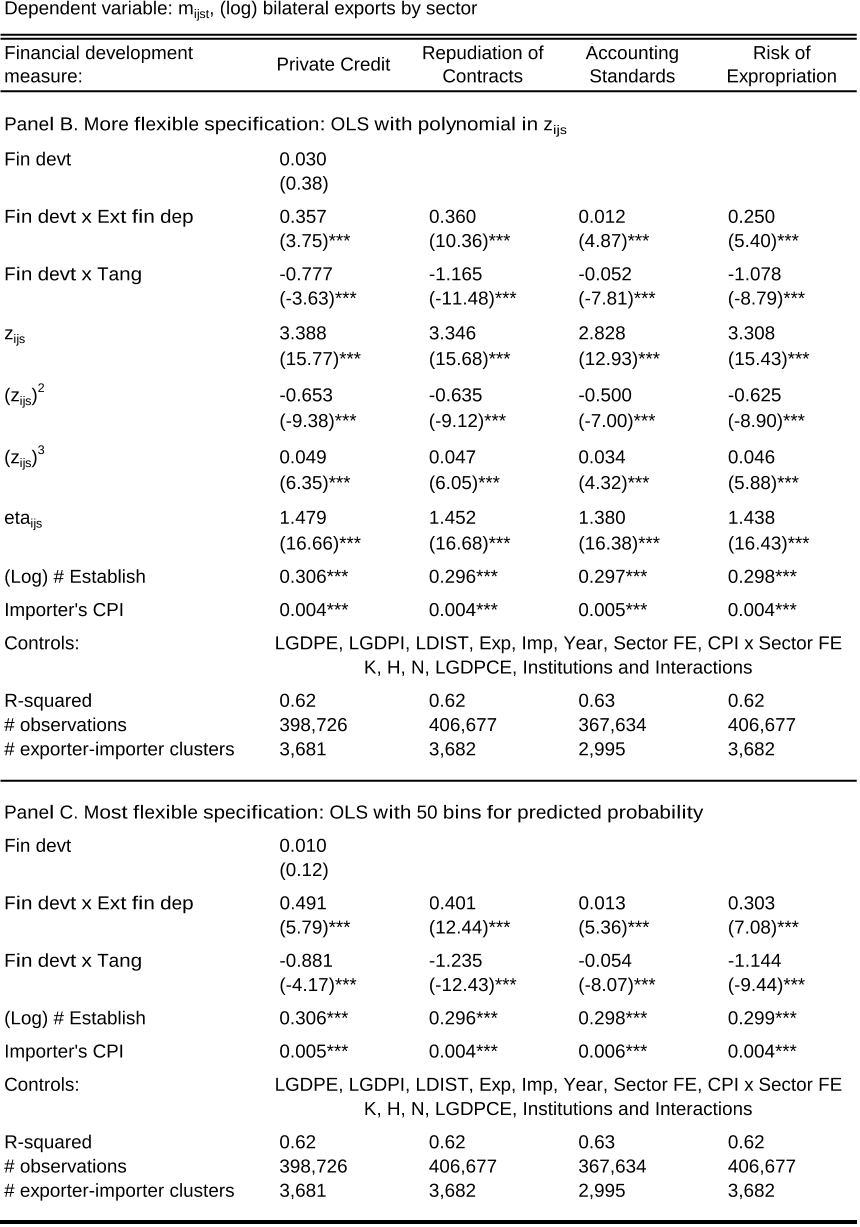Credit Constraints, Heterogeneous Firms and International Trade
Reads0
Chats0
TLDR
This article examined the detrimental consequences of financial market imperfections for international trade and developed a heterogeneous-firm model with countries at different levels of financial development and sectors of varying financial vulnerability.Abstract:
This paper examines the detrimental consequences of financial market imperfections for international trade. I develop a heterogeneous-firm model with countries at different levels of financial development and sectors of varying financial vulnerability. Applying this model to aggregate trade data, I study the mechanisms through which credit constraints operate. First, financial development increases countries' exports above and beyond its impact on overall production. Firm selection into exporting accounts for a third of the trade-specific effect, while two thirds are due to reductions in firm-level exports. Second, financially advanced economies export a wider range of products and their exports experience less product turnover. Finally, while all countries service large destinations, exporters with superior financial institutions have more trading partners and also enter smaller markets. All of these effects are magnified in financially vulnerable sectors. These results have important policy implications for less developed economies that rely on exports for economic growth but suffer from poor financial contractibility.read more
Figures

Table 10. Economic Significance: Predicted vs. Actual Trade Growth 
Table 9. Economic Significance: Comparative Statics 
Table 5. Financial Development and Firm-Level Exports 
Figure 3. The Productivity Cut-off for Exporting 
Table 5. Financial Development and Firm-Level Exports 
Table 1. Export Patterns in the Data
Citations
More filters
Posted Content
Estimating Trade Flows: Trading Partners and Trading Volumes
TL;DR: In this paper, the impact of trade frictions on trade flows can be decomposed into the intensive and extensive margins, where the former refers to the trade volume per exporter and the latter referred to the number of exporters.
Journal ArticleDOI
Finance and Development: A Tale of Two Sectors †
TL;DR: This article developed a model co-determining aggregate total factor productivity (TFP), sectoral TFP, and scales across industrial sectors and found that financial frictions disproportionately affect TFP in tradable sectors where production requires larger costs.
Posted Content
Exports and Financial Shocks
Mary Amiti,David E. Weinstein +1 more
TL;DR: In this article, a causal link between the health of banks providing trade finance and growth in a firm's exports relative to its domestic sales is established, suggesting that trade finance accounts for about one-third of the decline in Japanese exports in the financial crises of the 1990s.
Journal ArticleDOI
Off the Cliff and Back? Credit Conditions and International Trade During the Global Financial Crisis
TL;DR: This article studied the collapse of international trade flows during the global financial crisis using detailed data on monthly US imports and showed that credit conditions were an important channel through which the crisis affected trade volumes, by exploiting the variation in the cost of capital across countries and over time.
Journal ArticleDOI
The Empirics of Firm Heterogeneity and International Trade
Andrew B. Bernard,Andrew B. Bernard,Andrew B. Bernard,J. Bradford Jensen,J. Bradford Jensen,Stephen J. Redding,Peter K. Schott,Peter K. Schott,Peter K. Schott +8 more
TL;DR: A review of empirical evidence on firm heterogeneity in international trade can be found in this article, where a first wave of empirical findings from micro data on plants and firms proposed challenges for existing models of international trade and inspired the development of new theories emphasizing firm heterogeneity.
References
More filters
Posted Content
Financial Development, Property Rights, and Growth
TL;DR: Claessens and Laeven as mentioned in this paper investigated empirically whether firms in environments with more secure property rights allocate available resources more toward intangible assets and consequentially grow faster, finding that improved asset allocation due to better property rights has an effect on growth in sectoral value added equal to improved access to financing arising from greater financial development.
Journal ArticleDOI
Hysteresis, Import Penetration, and Exchange Rate Pass-Through
TL;DR: In this paper, a competitive industry has established home firms, and foreign firms with entry and exit costs are determined using methods of option pricing, and the real exchange rate follows a Brownian motion.
Journal ArticleDOI
Does a currency union affect trade? The time-series evidence
Reuven Glick,Andrew K. Rose +1 more
TL;DR: The authors used a large annual panel data set covering 217 countries from 1948 through 1997 during which a large number of countries left currency unions; they experienced economically and statistically signi4cant declines in bilateral trade, after accounting for other factors.
Journal ArticleDOI
Multi-Product Firms and Trade Liberalization
Andrew B. Bernard,Andrew B. Bernard,Andrew B. Bernard,Stephen J. Redding,Peter K. Schott,Peter K. Schott,Peter K. Schott +6 more
TL;DR: This paper developed a general equilibrium model of multi-product firms and analyzes their behavior during trade liberalization, finding that higher firm-level ability raises a firm's productivity across all products, which induces a positive correlation between a firms' intensive (output per product) and extensive (number of products) margins.
Journal ArticleDOI
Financial Development, Property Rights, and Growth
Stijn Claessens,Luc Laeven +1 more
TL;DR: In this paper, the authors investigate empirically whether firms in environments with more secure property rights allocate available resources more toward intangible assets and consequentially grow faster, finding that improved asset allocation due to better property rights has an effect on growth in sectoral value added equal to improved access to financing arising from greater financial development.